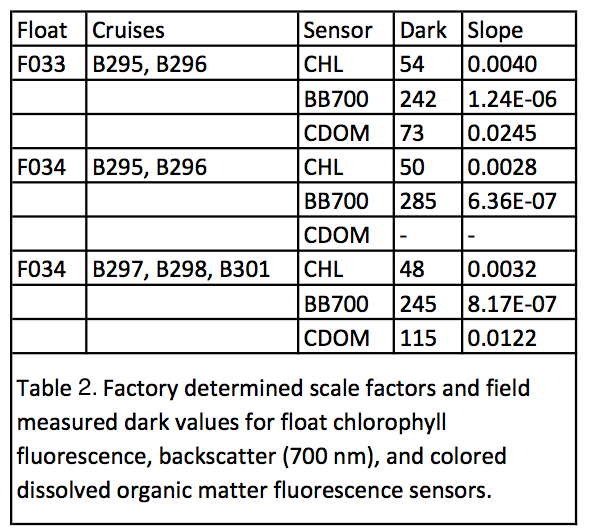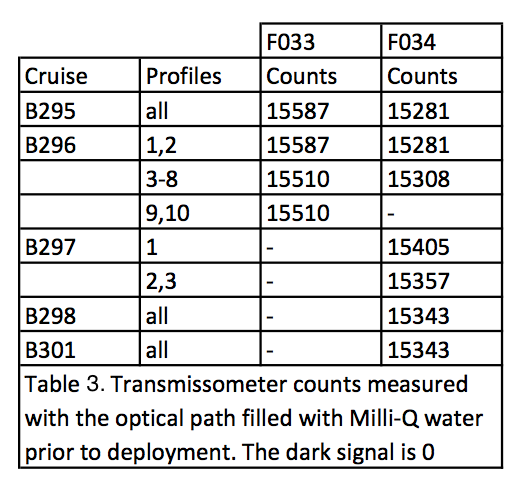Factory and field calibration data for float oxygen, beam transmission, backscatter, chlorophyll fluorescence and CDOM sensors from the Sargasso Sea from 2013-2014.
Project
Program
| Contributors | Affiliation | Role |
|---|---|---|
| Estapa, Margaret L. | Skidmore College | Principal Investigator, Contact |
| Buesseler, Kenneth O. | Woods Hole Oceanographic Institution (WHOI) | Co-Principal Investigator |
| Ake, Hannah | Woods Hole Oceanographic Institution (WHOI BCO-DMO) | BCO-DMO Data Manager |
Abstract
Factory and field calibration data for float oxygen, beam transmission, backscatter, chlorophyll fluorescence and CDOM sensors from the Sargasso Sea from 2013-2014.
Multiple deployments of two Sea-Bird Scientific Navis BGCi floats (numbers F033 and F034) equipped with CTDs, transmissometers, O2 optodes, backscattering (700 nm), fluorescence (chlorophyll, colored dissolved organic matter), and tilt sensors were conducted between July 2013 and November 2014 in conjunction with Bermuda Atlantic Time-series Study cruises. Short-term deployments (1.5 – 3 days) followed by recovery of the floats were conducted during four monthly BATS cruises in July – October 2013 and one cruise in March 2014. Both floats were deployed during the July and August 2013 cruises and float F034 was deployed for the remaining cruises. Each float collected one profile per cruise with the exception of the August 2013 cruise, during which the two floats together collected 13 profiles. During short-term deployments, floats first completed an initial descent and ascent without parking, then completed 1 or 2 more profile cycles with different, consecutive target depths. Following the initial descent/ascent described above, the short-term profile cycles were structured as described below for long-term deployments. In addition to the short-term cruise deployments, F033 profiled continuously from October 2013 until early April 2014, yielding 77 profiles, and F034 profiled continuously from March 2014 until late November 2014, yielding 139 profiles. During these long-term deployments, a typical cycle consisted of 1) the descent to the target park depth, 2) a park phase at the target depth lasting 1.5 – 2.5 days during which measurements are made every 15 minutes, 3) a descent to 1000 dbar, 4) an ascent to the surface during which measurements are made, and 5) a surface telemetry phase, during which a GPS fix is obtained, data are uploaded via Iridium, and instructions for the next cycle are downloaded. During long-term deployments, floats cycled through park phases at 150/200, 300, 500, and 1000 dbar every 7 days, spending 2.5 days at 1000 dbar and 1.5 days at the shallower depths. The sequence of park phase depth at the three shallowest depths was varied between each 7-day cycle over a 21-day period to avoid aliasing in particle flux profiles.
Refer to http://www.bco-dmo.org/project/2124 or http://bats.bios.edu for a description of BATS bottle sample acquisition.
The following are factory and field determined calibration coefficients for float oxygen, beam transmission, chlorophyll fluorescence, backscatter, and CDOM sensors. Calibrated float data are presented in the ‘Profile data’ (https://www.bco-dmo.org/dataset/728347) and ‘Park phase data’ (https://www.bco-dmo.org/dataset/728335) datasets’. Float oxygen, chlorophyll fluorescence, and backscatter data were additionally calibrated to BATS bottle samples from concurrent BATS cruises. When possible, each float sample collected in profile mode was matched to the BATS bottle sample nearest in potential density that was collected within a 10-km radius and ±15-m depth window of the float location within 1 d of the float sampling time. The BATS bottle data used for float calibration are provided for reference through the ‘Get Data’ link at the top of this page. Original BATS bottle data are available at http://www.bco-dmo.org/project/2124 or http://bats.bios.edu.



BCO-DMO Data Processing Description:
-Reformatted column names to comply with BCO-DMO standards.
-Data were originally organized into multiples files and have been consolidated for display here.
| File |
|---|
bottle.csv (Comma Separated Values (.csv), 3.04 KB) MD5:86fbd8701e9dae46325933a808c51ebc Primary data file for dataset ID 728371 |
| Parameter | Description | Units |
| Float_profile | Deployment number | unitless |
| Float_pressure | Float pressure | dbar |
| Float_O2 | Float dissolved oxygen concentration | umol/kg |
| Float_chla | Float chlorophyll-a | ug/L |
| Float_bbp | Float particulate backscattering coefficient | m -1 |
| Bottle_ID | BATS bottle ID number | unitless |
| BATS_Depth | BATS nominal depth where sample was taken | meters |
| BATS_O2 | BATS dissolved oxygen concentration | umol/kg |
| BATS_chla | BATS chlorophyll-a | ug/L |
| BATS_POC | BATS particulate organic carbon | mg/meters cubed |
| Dataset-specific Instrument Name | SBE 41CP CTD |
| Generic Instrument Name | CTD Sea-Bird |
| Dataset-specific Description | Used for sampling |
| Generic Instrument Description | A Conductivity, Temperature, Depth (CTD) sensor package from SeaBird Electronics. This instrument designation is used when specific make and model are not known or when a more specific term is not available in the BCO-DMO vocabulary. Refer to the dataset-specific metadata for more information about the specific CTD used. More information from: http://www.seabird.com/ |
| Dataset-specific Instrument Name | WET Labs MCOMS Chlorophyll Fluorometer |
| Generic Instrument Name | Fluorometer |
| Dataset-specific Description | Used for sampling |
| Generic Instrument Description | A fluorometer or fluorimeter is a device used to measure parameters of fluorescence: its intensity and wavelength distribution of emission spectrum after excitation by a certain spectrum of light. The instrument is designed to measure the amount of stimulated electromagnetic radiation produced by pulses of electromagnetic radiation emitted into a water sample or in situ. |
| Dataset-specific Instrument Name | WET Labs MCOMS Scattering Meter |
| Generic Instrument Name | Optical Backscatter Sensor |
| Dataset-specific Description | Used to sample backscatter |
| Dataset-specific Instrument Name | SBE63 optode |
| Generic Instrument Name | Oxygen Sensor |
| Dataset-specific Description | Used to sample dissolved oxygen |
| Generic Instrument Description | An electronic device that measures the proportion of oxygen (O2) in the gas or liquid being analyzed |
| Dataset-specific Instrument Name | Transmissometer |
| Generic Instrument Name | Transmissometer |
| Dataset-specific Description | Used to measure fraction of light |
| Generic Instrument Description | A transmissometer measures the beam attenuation coefficient of the lightsource over the instrument's path-length. This instrument designation is used when specific manufacturer, make and model are not known. |
Estapa_2013
| Website | |
| Platform | shoreside SargassoSea |
| Start Date | 2013-11-19 |
| End Date | 2014-11-24 |
AE1320
| Website | |
| Platform | R/V Atlantic Explorer |
| Report | |
| Start Date | 2013-09-15 |
| End Date | 2013-09-21 |
| Description | BATS cruise |
AE1318
| Website | |
| Platform | R/V Atlantic Explorer |
| Report | |
| Start Date | 2013-08-01 |
| End Date | 2013-08-10 |
| Description | BATS cruise |
AE1315
| Website | |
| Platform | R/V Atlantic Explorer |
| Report | |
| Start Date | 2013-07-06 |
| End Date | 2013-07-12 |
| Description | BATS cruise |
AE1323
| Website | |
| Platform | R/V Atlantic Explorer |
| Report | |
| Start Date | 2013-10-18 |
| End Date | 2013-10-23 |
| Description | BATs cruise |
AE1402
| Website | |
| Platform | R/V Atlantic Explorer |
| Report | |
| Start Date | 2014-03-04 |
| End Date | 2014-03-08 |
| Description | BATS cruise |
Rapid, Autonomous Particle Flux Observations in the Oligotrophic Ocean (RapAutParticleFlux)
Particles settling into the deep ocean remove carbon and biologically-important trace elements from sunlit, productive surface waters and from contact with the atmosphere over short timescales. A shifting balance among physical, chemical, and biological processes determines the ultimate fate of most particles at depths between 100 and 1,000 m, where fluxes are hardest to measure. Our challenge is to expand the number of particle flux observations in the critical "twilight zone", something that has proven elusive with ship-based “snapshots” that have lengths of, at most, a few weeks. Here, we propose an optical, transmissometer-based method to make particle flux observations from autonomous, biogeochemical profiling floats. Novel developments in data interpretation, sensor operation, and platform control now allow flux measurements at hourly resolution and give us observational access to the water-column processes driving particle flux over short timescales. The sensors and float platforms that we propose to use are simple, robust, and commercially-available, making them immediately compatible with community-scale efforts to implement other float-based biogeochemical measurements.
We have two main goals: First, we will quantify particulate organic carbon (POC) flux using float-based optical measurements by validating our observations against fluxes measured directly with neutrally-buoyant, drifting sediment traps. Second, we will evaluate the contribution of rapid export events to total POC fluxes in the oligotrophic ocean by using a biogeochemical profiling float to collect nearly-continuous, depth-resolved flux measurements and coupled, water-column bio-optical profiles.
To achieve these goals, we will implement a work plan consisting of 1) a set of laboratory-based sensor calibration experiments to determine detection limits and evaluate sensitivity to particle size; 2) a series of four sediment trap and biogeochemical float co-deployments during which we will collect POC flux and field calibration data; and 3) a long-term sampling and analysis period (approximately 1 year) during which data will be returned by satellite from the biogeochemical float. We will conduct calibration fieldwork in conjunction with monthly Bermuda Atlantic Time-series Study (BATS) cruises, taking advantage of the timeseries measurements and the context provided by the 25-year record of POC flux at that site. The data returned by the float will comprise the first quantitative particle flux observations made at high-enough temporal resolution to interpret in the context of short-term, upper-ocean production events.
Ocean Carbon and Biogeochemistry (OCB)
The Ocean Carbon and Biogeochemistry (OCB) program focuses on the ocean's role as a component of the global Earth system, bringing together research in geochemistry, ocean physics, and ecology that inform on and advance our understanding of ocean biogeochemistry. The overall program goals are to promote, plan, and coordinate collaborative, multidisciplinary research opportunities within the U.S. research community and with international partners. Important OCB-related activities currently include: the Ocean Carbon and Climate Change (OCCC) and the North American Carbon Program (NACP); U.S. contributions to IMBER, SOLAS, CARBOOCEAN; and numerous U.S. single-investigator and medium-size research projects funded by U.S. federal agencies including NASA, NOAA, and NSF.
The scientific mission of OCB is to study the evolving role of the ocean in the global carbon cycle, in the face of environmental variability and change through studies of marine biogeochemical cycles and associated ecosystems.
The overarching OCB science themes include improved understanding and prediction of: 1) oceanic uptake and release of atmospheric CO2 and other greenhouse gases and 2) environmental sensitivities of biogeochemical cycles, marine ecosystems, and interactions between the two.
The OCB Research Priorities (updated January 2012) include: ocean acidification; terrestrial/coastal carbon fluxes and exchanges; climate sensitivities of and change in ecosystem structure and associated impacts on biogeochemical cycles; mesopelagic ecological and biogeochemical interactions; benthic-pelagic feedbacks on biogeochemical cycles; ocean carbon uptake and storage; and expanding low-oxygen conditions in the coastal and open oceans.
| Funding Source | Award |
|---|---|
| NSF Division of Ocean Sciences (NSF OCE) |
[ table of contents | back to top ]